5+ Writing an Inspection Report Examples to Download
There is a joke that goes like this: If God created the world, then everything else is made in China. It’s not funny, but you got to admit that this fact is becoming truer and truer by the day. I mean look around you, almost anything you see are made by the Chinese.
They may be designed in other countries, or have a quality control inspection team from another country, but they are definitely made in China. Your cellphones, office equipment, appliances, kitchenware; almost anything is made there. And, you know what they say, Chinese products break easily. Well, that is only half true. One quality the Chinese are known for is their industriousness. You may also see report writings.
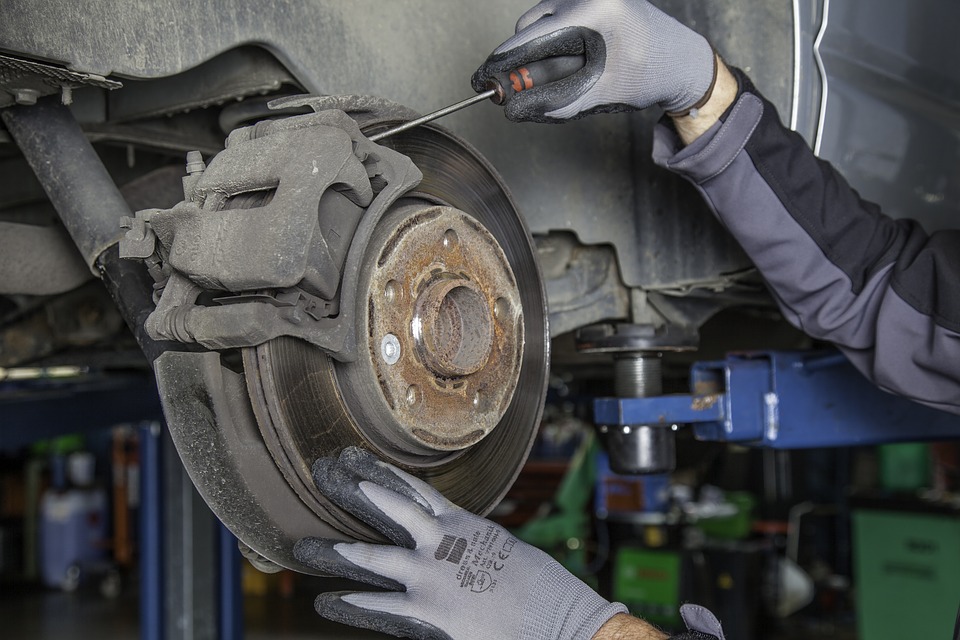
Unlike Japan, you will find many stalls selling Class A imitation products of many famous apparel brands (e.g. Nike, Adidas, Under Armour, Superdry, Asics, Onitsuka Tiger, Zara, Prada, Fenty, Kylie, Sperry). But, before they begin making these imitation products, they would have to scrutinize an original product first– its design details, the type of quality, the use, the logo, the add-ons that go along with it, etc.
Many of these imitation products look real, feel real, smell real, but it’s not. In the case of American products, their rejects would often go to an overruns outlet wherein they sell it for a cheaper price because of the errors they have made during the production process of the shirt (e.g. wrong stitching, incorrect logo placement, wrong color, etc.). But Japan is a totally different story. Japanese take pride in their work by making each product with care, precision, accuracy, and skill. You may also see free reports.
Japanese follow the philosophy of kaizen which is Japanese for “improvement”. This was first practiced in Japanese businesses after the Second World War, influenced by American business and quality-management teachers, and most notably as part of The Toyota Way. In business, this concept refers to activities that continually improve all functions and involve all employees from the CEO to the assembly line workers.
But, last October 2017, a shocking revelation from Kobe Steel Ltd., a major Japanese steel manufacturer admitted that had been falsifying quality certificates for metal products used for cars, aircraft, and trains. “Corporate Japan is wondering if its prestige has suffered an irreparable blow,” the Nikkei Asian Review wrote. “The brand, reputation, the sustainability of Japanese companies rest on quality,” a corporate-governance group told Bloomberg News. You may also see activity reports.
Inspection Report Template
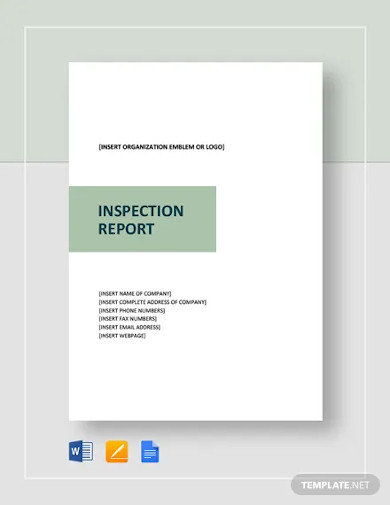
Restaurant Inspection Report Template
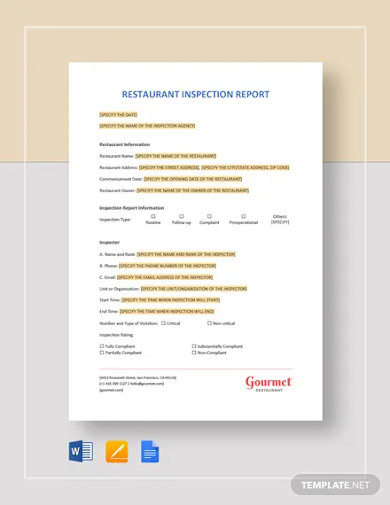
Home Inspection Report Template
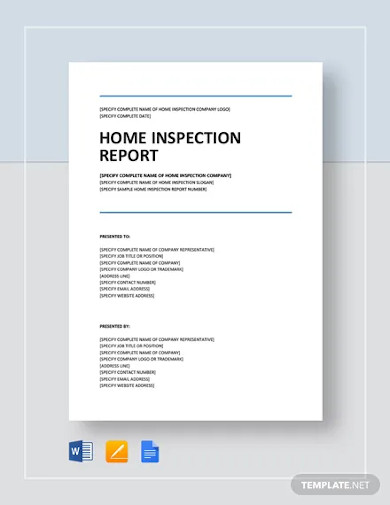
Construction Inspection Report Template

Buyer’s Property Inspection Report Template

Building Inspection Report Sample Template
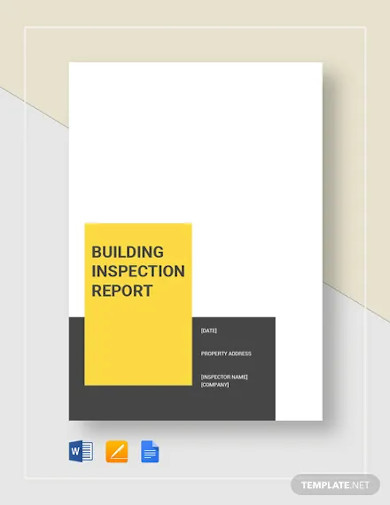
Issuing a Quality Inspection Report
So, how do we prevent this from happening again? Aside from getting honest-to-goodness people who would actually conduct a routine inspection of their products, it is also important to write down an inspection report so that you may know how many items are deemed defective. Following are five key steps:
1. Know your audience
Remember that no two products are alike. A shirt from Nike and Under Armour may have similarities, but it is not made the same. So, make sure in making the report, it is understood by everyone to give them a general issue of what seems to be the issue at hand. It is also important to understand the difference between the following reports:
a. Internal reports are intended to stay within the company, but this can convey a false sense of security, as these reports do not always remain internal.
b. External reports include those of suppliers, service providers, customers, regulators, and others outside the business. You may also see monthly reports.
c. Executive reports usually require brevity.
d. A confidential report is another false sense of security as these reports may not remain confidential.

2. Four sections
The four basic sections are included in a well-written inspection report.
a. “Title” page or cover memo summarizing the date, along with the subject, its recipients, the main purpose or goal, the participants involved, the gist/description of the activity and other basic information.
b. “Executive brief” which summarizes the main issue(s) which are normally a few systematic flaws leading to numerous observations. All priorities are made in this particular section. You may also see consulting reports.
c. “Contents” – A chronological or systematic order of observations. After noting said observations, there should be room for recommendations for every observation made. Although discussions should be noted, be careful with writing opinions. It is better for analysis and opinions to come out during a review meeting. The recommendation may not be the right solution as an idea may lead to a better solution. You may also see medical reports.
d. “Conclusion” highlighting key points, planned actions, and next steps. You may also see project reports.
3. Good writing tips
Well-written reports should try to include as many details as possible with a clear description for each of them. For example, “Observed insect trails in approximately 40 pounds of flour on the floor under a leaking sifter pipe.” This description is better than “Observed a lot of flour on the floor.” Other tips are to have short sentences, avoid repetition and redundancy, write with clarity, using numbered listing, avoiding acronyms, send a short message with the first sentence of each paragraph, use a direct precise writing style, proofreading your report, use an easy-to-read font, and follow correct spacing.
Another characteristic is to recognize the good with the bad. Many inspection and audit reports do not recognize proper industry practices. Learn to commend the employees if they really deserve it. You may also see performance reports.

4. Formal reports require formal responses
Responses should be drafted as soon as possible. Most responses should be the result of a follow-up meeting which documents on what has been done, if it can be done, when it will be done, and by whom will it be done. To better manage follow-up activities, try using the original report with two blank columns on the right side, titled “assigned to” and “completed on.” A well-written inspection report, formatted for action, is documenting action all in one place. You may also see sales reports.
5. Require a follow-up process
Following up the corrective action is very important to make sure that the necessary corrections are being applied. Almost anyone can determine priorities and identify accountability, assignments, and target dates by pulling information from a report. Discussions help responsible persons understand the issues, both acute and chronic, and develop best solutions. The team agrees to assignments with agreeable completion dates is a necessity for corrective action. Documenting action and dates in one report is an approach to help prevent repeating problems. You may also see marketing reports.
Quality control is key. Forging of a Japanese sword is a subtle and careful process, an art that has developed over the centuries as much in response to stylistic and aesthetic considerations as to technical improvements. To fashion these blades, the Smith not only must possess physical strength, but also patience, dexterity, and a refined eye for the limits of the material and the beauty of a finished sword. When made with love, compassion, precision, meticulousness, and accuracy, these swords can range up to $50,000. You may also see monthly reports.


